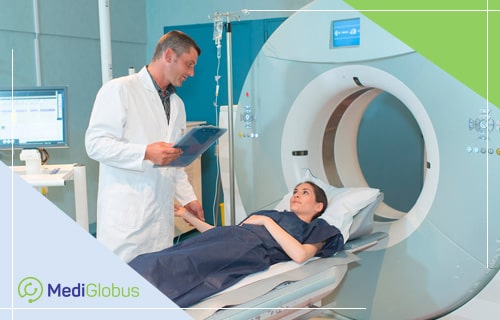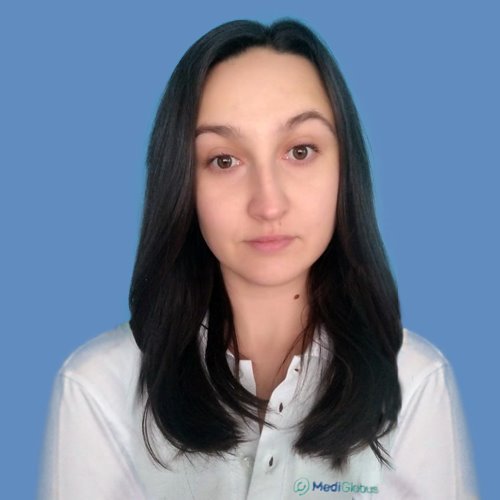PET-CT is a unique method of diagnostics, which combines the possibilities of positron emission and computed tomography. In 30% of cases after this procedure, foreign doctors change the previously prescribed treatment. This is especially important for patients coming from third-world countries. Why PET-CT is such an important examination, where it is carried out and how is it done – learn from experts of the international medical platform MediGlobus.
What is PET-CT?

Positron emission computed tomography (PET-CT) is a modern radionuclide diagnostic method. It makes it possible to examine human organs and systems in the smallest detail with only one procedure.
Even the smallest tumour structures and non-cancerous lesions can be detected with PET, and a CT scan determines their exact location.
This study provides an opportunity to display metabolic processes in cells and recreate detailed images of internal organs. The combination of PET and CT images results in a more complete anatomical and metabolic imaging of the affected areas throughout the body.
It takes about 3 days to conduct the procedure abroad. First, the patient has a consultation with a doctor. If necessary, they perform laboratory tests to detect contraindications to the examination.
Before the examination, the patient is given a small dose of radioactive material, the so-called indicator. Glucose marked with radioactive fluoride is usually used for this purpose. Other radioactive substances may be used. With the help of a special measuring unit – the detector – the radiation emitted by the substance stored in tissues is detected. The dosage of the radiopharmaceutical substance is calculated for each patient individually. It is done following international standards and is calculated taking into account the weight, height and age of the patient.
Modern PET-CT units are equipped with a special image processing program and filters to reduce X-ray dose. The imaging program clearly shows the state of the area to be scanned and removes unnecessary noise and defects. The duration of the diagnosis is approximately 30 minutes. The patient receives the results in 2-3 days.
Types of PET Tomography
PET-CT with gallium 68 | One of the most modern diagnostic methods of oncology, in particular prostate cancer. The procedure involves the introduction of a special contrast agent that connects to tumour cells according to the type of lock. This substance is Gallium 68. It was first produced in 2014 in Germany. For more than 6 years of use, the method has proven itself in the detection of relapses, residual cells and prostate cancer metastases. |
PET-CT with 18F-fluorodeoxyglucose | Whole-body PET/CT is performed with 18F fluorodeoxyglucose. This drug is analogous to natural glucose. It allows evaluating the glycolytic activity of the tissues in which the glycolysis process takes place – stomach, liver, muscles, brain, etc. Many cancerous tumours have increased glucose metabolism. Therefore, studies with this substance demonstrate high diagnostic effectiveness. 18F-fluorodeoxyglucose is used to assess the prevalence and dynamic observation of lymphoma, melanoma, osteoarthritis, neck cancer and other oncopathologies. |
PET-CT with methionine | PET scans with methionine are used to diagnose malignant brain diseases, in particular gliomas. This substance helps to detect soft tissue diseases more accurately compared to 18F-fluorodeoxyglucose. In the case of the brain, the difference in speed and amount of glucose accumulation is not so obvious. For the central nervous system, accelerated uptake of glucose preparations is a physiological norm.
Brain cancers have accelerated protein metabolism and increased vascular permeability. They intensively accumulate drugs with methionine, an amino acid that is part of human proteins. Therefore, in the study of the brain scan with methionine – a priority method of diagnosis. Radio enzyme belongs to the group of natural metabolites and is considered safe for the patient’s health. It is often used in the diagnosis of cancer in children. |
PET-CT with tyrosine | Tyrosine is used to identify malignant and benign brain tumours. It is also shown in the detection of relapses of brain cancer. It is prescribed after radiation therapy or surgery. In this case, tyrosine evaluates the effectiveness of oncotherapy. |
Choline PET-CT | Choline is similar in its composition and structure to B vitamins. This drug has a pronounced antidepressive and sedative effect. It is used to lower blood cholesterol levels. PET-CT with choline is prescribed for liver cancer, multiple myeloma, parathyroid adenoma, prostate cancer. The results of the study allow detecting recurrence of the disease, to differentiate the tumour, to determine the stage of oncology and choose the optimal treatment tactics. |
Which diagnoses require a PET-CT study?
PET-CT is the “gold standard” in the diagnosis of more than 65% of all oncopathologies. Thanks to the examination it is possible to accurately determine the location, size and stage of the malignant process. This procedure is considered an integral part of the detection of such cancers as:
multiple myeloma;
bronchial and lung cancer;
chronic lymphocytic leukaemia;
gynaecological oncopathologies;
malignant lesions of the oesophagus;
spinal cord cancer;
rectal oncology;
malignant tumours of tonsils.
The research is carried out to evaluate the effectiveness of the performed oncotherapy program and to detect tumour recurrence. It is also shown when planning radiation therapy and determining the most “aggressive” malignant process focus for biopsy. The decoding of PET-CT results is performed by a qualified nuclear medicine specialist.
According to the European Association of Nuclear Medicine, accurate and early diagnosis of oncology requires one PET-CT unit per 1.5 to 2 million people. Not all countries can meet this criterion. The statistics are as follows:
| Country | Number of PET-CT devices |
| Turkey | 3 devices per 1.5 million people |
| Israel | 2 devices per 1.5 million people |
| Germany | 1 device per 1 million people |
| Russia | 1 device per 5 million people |
| Ukraine | 1 device per 14 million people |
Indications for positron emission tomography

The PET-CT unit produces a minimal dose of radiation. The radioactive substance leaves the body after 24 hours and does not harm it.
This procedure has clear indications. It’s only administered by the attending physician. A CT scan is necessary for a diagnosis of:
cancerous tumours;
diseases of the cardiovascular system;
brain and spinal cord pathologies;
neurological disorders, etc.
Contraindications to PET-CT
Although the study carries minimal health risks to the patient, it has some contraindications. This diagnostic method cannot be used for the following conditions and diseases:
kidney failure (it slows down the removal of the radioactive substance from the body and distorts the results of diagnosis);
infectious diseases;
chronic diseases in the acute stage;
severe neuropsychiatric disorders (schizophrenia, dementia);
pancreatic diabetes (a study using fluorodeoxyglucose requires a previous correction of blood sugar levels);
pregnancy and breastfeeding (breastfeeding should be stopped for 24 hours after the scan);
chemotherapy (diagnosis is made 10-12 days after the completion of the antitumor drugs);
radiotherapy (positron emission computer scanning of the body is possible not earlier than 12 weeks after radiation therapy);
postoperative period (PET-diagnostics can be done not earlier than 2 months after the surgery).
How will the patient prepare for the study?

Before the procedure, the patient must follow a diet for at least 24 hours and fast for about 6 hours. On the day of the examination, he or she will rest for a minimum of 15 minutes. This calms down and reduces muscle activity, which can be interpreted as a metabolic disorder.
Additional training requirements will be advised by the doctor. The patient may need to undergo some examinations that will confirm that they are ready to perform the procedure.
1-2 hours before PET-CT, the patient is given intravenous radiopharmaceuticals. Then they are placed in the device, usually lying on their back, hands on the sides or gathered together above the head. The patient’s location depends on the area to be examined.
Cost of PET-CT
The price of a positron emission tomography is calculated based on the type of examination and level of the clinic. Each state has its pricing policy for medical services, so the cost of this procedure is different for each country. The lowest cost of PET is found in China, India and Turkey.
The approximate cost of PET-CT abroad is:
| Country | Cost of PET-CT |
|---|---|
| Turkey | from $1,000 |
| India | from $650 |
| China | from $650 |
| South Korea | from $1,400 |
| Country | Cost of PET-CT |
|---|---|
| Israel | from $1,550 |
| Germany | from €1,600 |
| Spain | from €1,400 |
| The Czech Republic | from €1,300 |
In the price of PET-CT, most clinics include only radiopharmaceuticals and the study itself. However, some medical centres offer a package that includes not only diagnostics, but also a doctor’s consultation, transfer, accommodation, and interpreter.
Where do PET diagnostics take place abroad?
Researches are carried out in diagnostic departments of leading wide profile and highly specialized clinics of the world. Among them:
Liv Hospital Network in Turkey;
Ichilov Clinic in Israel;
Soon Chun Hyang Hospital in South Korea;
Fuda Oncocenter in China;
BLK Hospital in India;
Quironsalud Hospitals Group in Spain;
Memorial Medical Group Hospitals in Turkey;
Ludwig-Maximilian clinic in Germany;
Motol Hospital in the Czech Republic.
Resume
PET-CT is a unique method of diagnostics, which combines the possibilities of positron emission and computed tomography. In 30% of cases after this procedure, foreign doctors change the previously prescribed treatment. This is especially important for patients coming from third-world countries.
PET-CT is the “gold standard” in the diagnosis of more than 65% of all oncopathologies. Thanks to the examination, it is possible to accurately determine the location, size and stage of the malignant process. The results are decoded by a radiation oncologist.
The price of a positron emission tomography depends on the type of examination and level of the clinic. Each state has its pricing policy for medical services, so the cost of this procedure is different for each country. The lowest price of PET is found in China, India and Turkey.
Key countries for this test are Turkey, Spain, India, Korea, Israel, Germany and the Czech Republic.
If you need to have PET-CTs performed abroad, please contact the MediGlobus coordination physicians. We will find you the best option for your medical trip and help with its organization. Leave your application!





